bonnet PEUGEOT 4007 2009 Owners Manual
[x] Cancel search | Manufacturer: PEUGEOT, Model Year: 2009, Model line: 4007, Model: PEUGEOT 4007 2009Pages: 230, PDF Size: 16.57 MB
Page 124 of 230
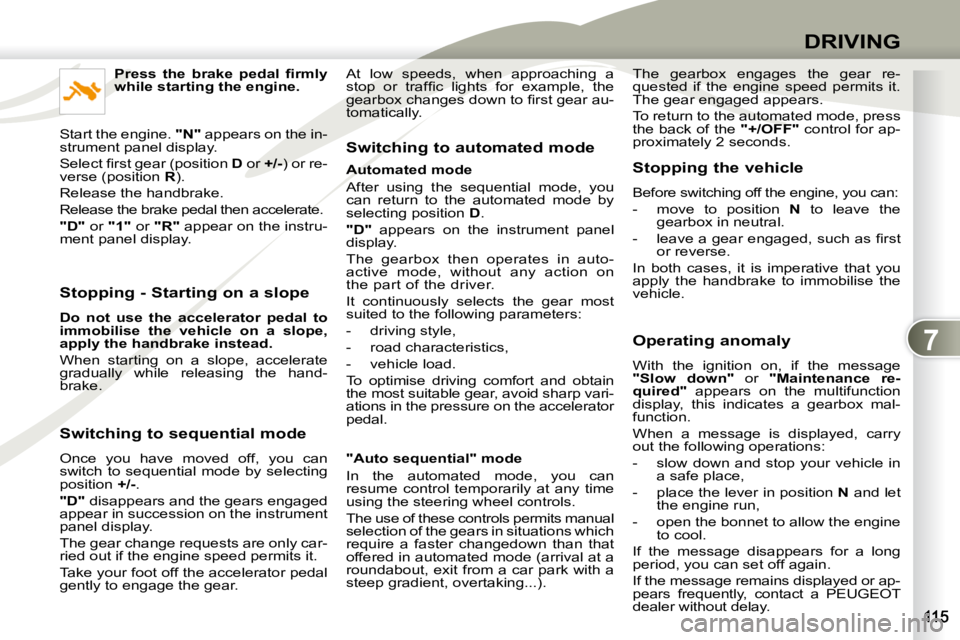
7
DRIVING
Stopping - Starting on a slope
Do not use the accelerator pedal to
immobilise the vehicle on a slope,
apply the handbrake instead.
When starting on a slope, accelerate
gradually while releasing the hand-
brake.
Switching to sequential mode
Once you have moved off, you can
switch to sequential mode by selecting
position +/- .
"D" disappears and the gears engaged
appear in succession on the instrument
panel display.
The gear change requests are only car-
ried out if the engine speed permits it.
Take your foot off the accelerator pedal
gently to engage the gear. Switching to automated mode
Automated mode
After using the sequential mode, you
can return to the automated mode by
selecting position
D .
"D" appears on the instrument panel
display.
The gearbox then operates in auto-
active mode, without any action on
the part of the driver.
It continuously selects the gear most
suited to the following parameters:
- driving style,
- road characteristics,
- vehicle load.
To optimise driving comfort and obtain
the most suitable gear, avoid sharp vari-
ations in the pressure on the accelerator
pedal.
"Auto sequential" mode
In the automated mode, you can
resume control temporarily at any time
using the steering wheel controls.
The use of these controls permits manual
selection of the gears in situations which
require a faster changedown than that
offered in automated mode (arrival at a
roundabout, exit from a car park with a
steep gradient, overtaking...). Stopping the vehicle
Before switching off the engine, you can:
- move to position
N to leave the
gearbox in neutral.
� � �-� � �l�e�a�v�e� �a� �g�e�a�r� �e�n�g�a�g�e�d�,� �s�u�c�h� �a�s� �fi� �r�s�t� or reverse.
In both cases, it is imperative that you
apply the handbrake to immobilise the
vehicle.
Operating anomaly
With the ignition on, if the message
"Slow down" or "Maintenance re-
quired" appears on the multifunction
display, this indicates a gearbox mal-
function.
When a message is displayed, carry
out the following operations:
- slow down and stop your vehicle in a safe place,
- place the lever in position N and let
the engine run,
- open the bonnet to allow the engine to cool.
If the message disappears for a long
period, you can set off again.
If the message remains displayed or ap-
pears frequently, contact a PEUGEOT
dealer without delay.
�P�r�e�s�s� �t�h�e� �b�r�a�k�e� �p�e�d�a�l� �fi� �r�m�l�y�
while starting the engine.
Start the engine. "N" appears on the in-
strument panel display.
� �S�e�l�e�c�t� �fi� �r�s�t� �g�e�a�r� �(�p�o�s�i�t�i�o�n� � D or +/- ) or re-
verse (position R ).
Release the handbrake.
Release the brake pedal then accelerate.
"D" or "1" or "R" appear on the instru-
ment panel display. The gearbox engages the gear re-
quested if the engine speed permits it.
The gear engaged appears.
To return to the automated mode, press
the back of the
"+/OFF" control for ap-
proximately 2 seconds.
At low speeds, when approaching a
�s�t�o�p� �o�r� �t�r�a�f�fi� �c� �l�i�g�h�t�s� �f�o�r� �e�x�a�m�p�l�e�,� �t�h�e�
�g�e�a�r�b�o�x� �c�h�a�n�g�e�s� �d�o�w�n� �t�o� �fi� �r�s�t� �g�e�a�r� �a�u�-
tomatically.
Page 128 of 230
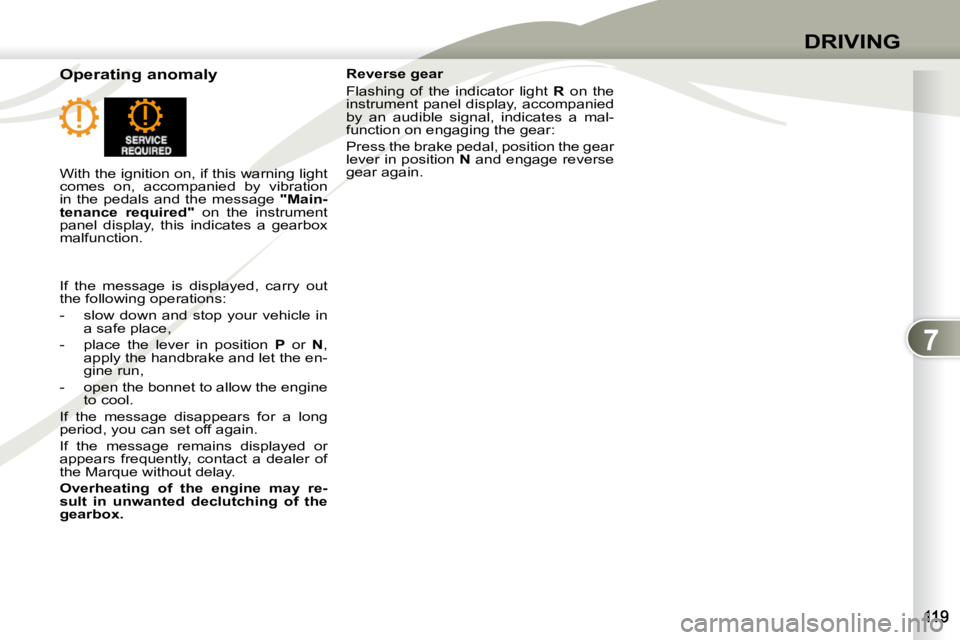
7
DRIVING
Operating anomaly Reverse gear
Flashing of the indicator light
R on the
instrument panel display, accompanied
by an audible signal, indicates a mal-
function on engaging the gear:
Press the brake pedal, position the gear
lever in position N and engage reverse
gear again.
With the ignition on, if this warning light
comes on, accompanied by vibration
in the pedals and the message "Main-
tenance required" on the instrument
panel display, this indicates a gearbox
malfunction.
If the message is displayed, carry out
the following operations:
- slow down and stop your vehicle in a safe place,
- place the lever in position P or N ,
apply the handbrake and let the en-
gine run,
- open the bonnet to allow the engine to cool.
If the message disappears for a long
period, you can set off again.
If the message remains displayed or
appears frequently, contact a dealer of
the Marque without delay.
Overheating of the engine may re-
sult in unwanted declutching of the
gearbox.
Page 136 of 230
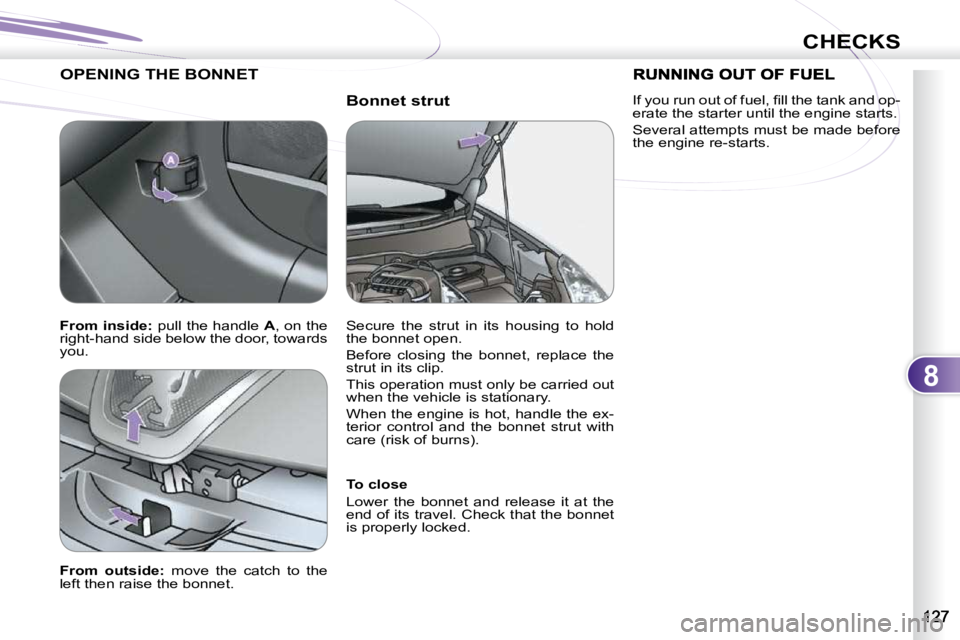
8
CHECKS
Bonnet strut
OPENING THE BONNET
To close
Lower the bonnet and release it at the
end of its travel. Check that the bonnet
is properly locked.
From outside: move the catch to the
left then raise the bonnet. Secure the strut in its housing to hold
the bonnet open.
Before closing the bonnet, replace the
strut in its clip.
This operation must only be carried out
when the vehicle is stationary.
When the engine is hot, handle the ex-
terior control and the bonnet strut with
care (risk of burns).
From inside: pull the handle A , on the
right-hand side below the door, towards
you. � � �I�f� �y�o�u� �r�u�n� �o�u�t� �o�f� �f�u�e�l�,� �fi� �l�l� �t�h�e� �t�a�n�k� �a�n�d� �o�p�-
erate the starter until the engine starts.
Several attempts must be made before
the engine re-starts.
Page 139 of 230
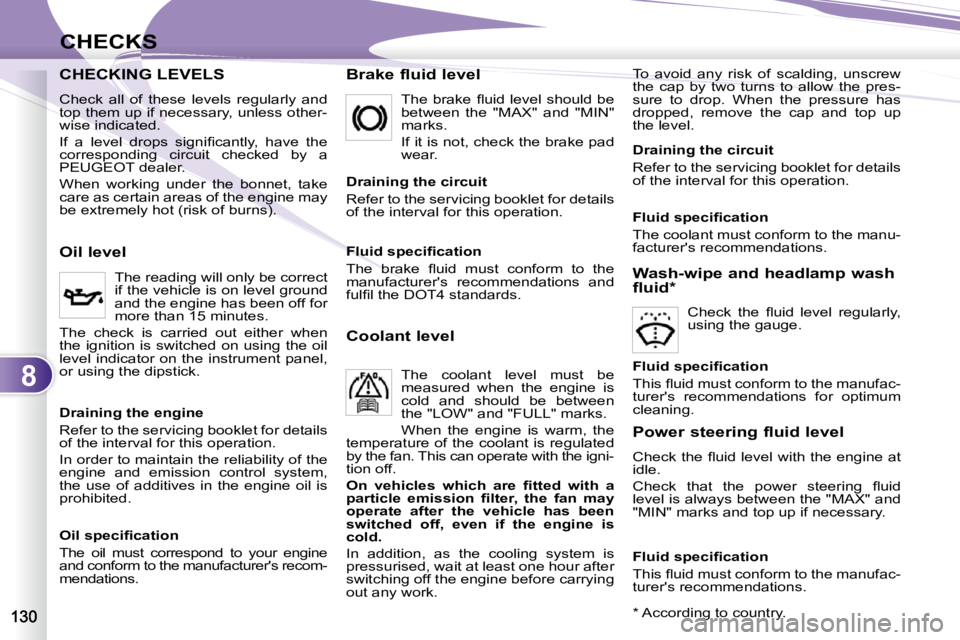
8
CHECKS
CHECKING LEVELS CHECKING LEVELS Brake fluid level To avoid any risk of scalding, unscrew
the cap by two turns to allow the pres-
sure to drop. When the pressure has
dropped, remove the cap and top up
the level.
Oil level The reading will only be correct
if the vehicle is on level ground
and the engine has been off for
more than 15 minutes.
The check is carried out either when
the ignition is switched on using the oil
level indicator on the instrument panel,
or using the dipstick. � �T�h�e� �b�r�a�k�e� �fl� �u�i�d� �l�e�v�e�l� �s�h�o�u�l�d� �b�e�
between the "MAX" and "MIN"
marks.
If it is not, check the brake pad
wear.
Draining the circuit
Refer to the servicing booklet for details
of the interval for this operation.
Coolant level
The coolant level must be
measured when the engine is
cold and should be between
the "LOW" and "FULL" marks.
When the engine is warm, the
temperature of the coolant is regulated
by the fan. This can operate with the igni-
tion off.
� � �O�n� �v�e�h�i�c�l�e�s� �w�h�i�c�h� �a�r�e� �fi� �t�t�e�d� �w�i�t�h� �a�
�p�a�r�t�i�c�l�e� �e�m�i�s�s�i�o�n� �fi� �l�t�e�r�,� �t�h�e� �f�a�n� �m�a�y�
operate after the vehicle has been
�s�w�i�t�c�h�e�d� �o�f�f�,� �e�v�e�n� �i�f� �t�h�e� �e�n�g�i�n�e� �i�s�
cold.
In addition, as the cooling system is
pressurised, wait at least one hour after
switching off the engine before carrying
out any work. Wash-wipe and headlamp wash
fluid*
� �C�h�e�c�k� �t�h�e� �fl� �u�i�d� �l�e�v�e�l� �r�e�g�u�l�a�r�l�y�,�
using the gauge.
* According to country.
Draining the engine
Refer to the servicing booklet for details
of the interval for this operation.
In order to maintain the reliability of the
engine and emission control system,
the use of additives in the engine oil is
prohibited.
� � �O�i�l� �s�p�e�c�i�fi� �c�a�t�i�o�n�
The oil must correspond to your engine
and conform to the manufacturer's recom-
mendations. � � �F�l�u�i�d� �s�p�e�c�i�fi� �c�a�t�i�o�n�
� �T�h�e� �b�r�a�k�e� �fl� �u�i�d� �m�u�s�t� �c�o�n�f�o�r�m� �t�o� �t�h�e�
manufacturer's recommendations and
�f�u�l�fi� �l� �t�h�e� �D�O�T�4� �s�t�a�n�d�a�r�d�s�.� � �
Draining the circuit
Refer to the servicing booklet for details
of the interval for this operation.
� � �F�l�u�i�d� �s�p�e�c�i�fi� �c�a�t�i�o�n�
The coolant must conform to the manu-
facturer's recommendations.
� � �F�l�u�i�d� �s�p�e�c�i�fi� �c�a�t�i�o�n�
� �T�h�i�s� �fl� �u�i�d� �m�u�s�t� �c�o�n�f�o�r�m� �t�o� �t�h�e� �m�a�n�u�f�a�c�-
turer's recommendations for optimum
cleaning.
Power steering fluid level
� �C�h�e�c�k� �t�h�e� �fl� �u�i�d� �l�e�v�e�l� �w�i�t�h� �t�h�e� �e�n�g�i�n�e� �a�t�
idle.
� �C�h�e�c�k� �t�h�a�t� �t�h�e� �p�o�w�e�r� �s�t�e�e�r�i�n�g� �fl� �u�i�d�
level is always between the "MAX" and
"MIN" marks and top up if necessary.
� � �F�l�u�i�d� �s�p�e�c�i�fi� �c�a�t�i�o�n�
� �T�h�i�s� �fl� �u�i�d� �m�u�s�t� �c�o�n�f�o�r�m� �t�o� �t�h�e� �m�a�n�u�f�a�c�-
turer's recommendations.
Check all of these levels regularly and
top them up if necessary, unless other-
wise indicated.
� �I�f� �a� �l�e�v�e�l� �d�r�o�p�s� �s�i�g�n�i�fi� �c�a�n�t�l�y�,� �h�a�v�e� �t�h�e�
corresponding circuit checked by a
PEUGEOT dealer.
When working under the bonnet, take
care as certain areas of the engine may
be extremely hot (risk of burns).
Page 155 of 230

9
PRACTICAL INFORMATION
CHANGING A FUSE CHANGING Changing a fuse
Before changing a fuse, the cause
�o�f� �t�h�e� �f�a�i�l�u�r�e� �m�u�s�t� �b�e� �i�d�e�n�t�i�fi� �e�d� �a�n�d�
�r�e�c�t�i�fi� �e�d�.�
� Identify the faulty fuse by checking
�t�h�e� �c�o�n�d�i�t�i�o�n� �o�f� �i�t�s� �fi� �l�a�m�e�n�t�.� �
Access to the tools
� �T�h�e� �e�x�t�r�a�c�t�i�o�n� �p�l�i�e�r�s� �a�r�e� �i�n�s�t�a�l�l�e�d� �i�n� �t�h�e�
�e�n�g�i�n�e� �c�o�m�p�a�r�t�m�e�n�t� �f�u�s�e� �b�o�x�.�
To gain access to them:
� Open the bonnet (refer to the "Ac-
cess" section),
� Press on the hook A and release
the catch,
� Remove the cover completely,
� Remove the pliers B . Correct Incorrect
� � � �U�s�e� �t�h�e� �s�p�e�c�i�a�l� �p�l�i�e�r�s� �t�o� �e�x�t�r�a�c�t� �t�h�e�
fuse from its location.
� Always replace the faulty fuse with
a fuse of the same rating.
� Check the correspondence between
�t�h�e� �n�u�m�b�e�r� �e�t�c�h�e�d� �o�n� �t�h�e� �b�o�x�,� �t�h�e�
rating etched on the top and the ta-
bles below.
The spare fuses are located on
the engine compartment fuse
�b�o�x� �c�o�v�e�r�.� Your vehicle’s electrical sys-
tem is designed to operate with
standard or optional equipment.
Before installing other electrical
equipment or accessories in your
vehicle, contact a PEUGEOT
dealer.
PEUGEOT will not accept re-
sponsibility for the cost incurred in
repairing your vehicle or for rec-
tifying the malfunctions resulting
from the installation of accesso-
ries not supplied and not recom-
mended by PEUGEOT and not
installed in accordance with its in-
structions, in particular when the
consumption of all of the addition-
�a�l� �e�q�u�i�p�m�e�n�t� �c�o�n�n�e�c�t�e�d� �e�x�c�e�e�d�s�
10 milliamperes.
Page 158 of 230
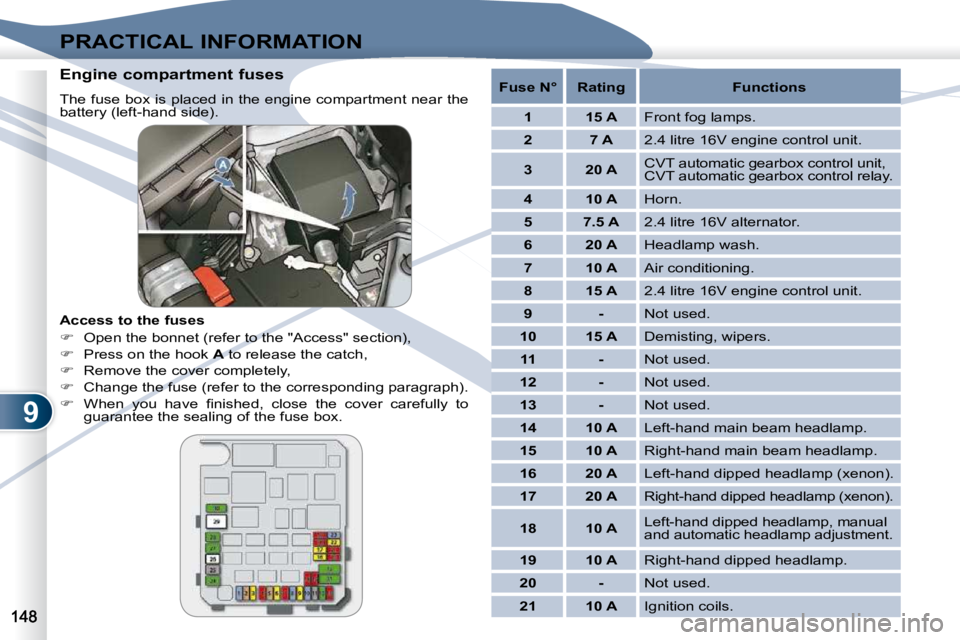
9
PRACTICAL INFORMATION
Engine compartment fuses
� �T�h�e� �f�u�s�e� �b�o�x� �i�s� �p�l�a�c�e�d� �i�n� �t�h�e� �e�n�g�i�n�e� �c�o�m�p�a�r�t�m�e�n�t� �n�e�a�r� �t�h�e�
battery (left-hand side).
Access to the fuses
� Open the bonnet (refer to the "Access" section),
� Press on the hook A to release the catch,
� Remove the cover completely,
� Change the fuse (refer to the corresponding paragraph).
� � � �W�h�e�n� �y�o�u� �h�a�v�e� �fi� �n�i�s�h�e�d�,� �c�l�o�s�e� �t�h�e� �c�o�v�e�r� �c�a�r�e�f�u�l�l�y� �t�o�
�g�u�a�r�a�n�t�e�e� �t�h�e� �s�e�a�l�i�n�g� �o�f� �t�h�e� �f�u�s�e� �b�o�x�.� �
Fuse N° Rating Functions
1 15 A Front fog lamps.
2 7 A 2.4 litre 16V engine control unit.
3 20 A � �C�V�T� �a�u�t�o�m�a�t�i�c� �g�e�a�r�b�o�x� �c�o�n�t�r�o�l� �u�n�i�t�,�
�C�V�T� �a�u�t�o�m�a�t�i�c� �g�e�a�r�b�o�x� �c�o�n�t�r�o�l� �r�e�l�a�y�.�
4 10 A Horn.
5 7.5 A 2.4 litre 16V alternator.
6 20 A Headlamp wash.
7 10 A Air conditioning.
8 15 A 2.4 litre 16V engine control unit.
9 - Not used.
10 15 A Demisting, wipers.
11 - Not used.
12 - Not used.
13 - Not used.
14 10 A Left-hand main beam headlamp.
15 10 A Right-hand main beam headlamp.
16 20 A � �L�e�f�t�-�h�a�n�d� �d�i�p�p�e�d� �h�e�a�d�l�a�m�p� �(�x�e�n�o�n�)�.�
17 20 A � �R�i�g�h�t�-�h�a�n�d� �d�i�p�p�e�d� �h�e�a�d�l�a�m�p� �(�x�e�n�o�n�)�.�
18 10 A Left-hand dipped headlamp, manual
and automatic headlamp adjustment.
19 10 A Right-hand dipped headlamp.
20 - Not used.
21 10 A Ignition coils.
Page 160 of 230
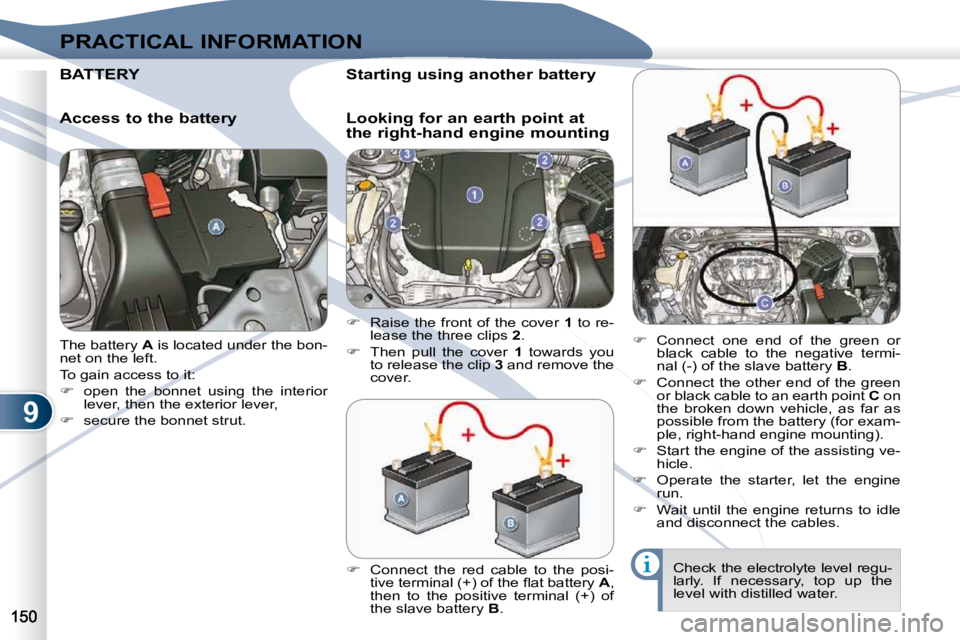
9
PRACTICAL INFORMATION
The battery A is located under the bon-
net on the left.
To gain access to it:
� open the bonnet using the interior
�l�e�v�e�r�,� �t�h�e�n� �t�h�e� �e�x�t�e�r�i�o�r� �l�e�v�e�r�,�
� secure the bonnet strut.
BATTER BATTERY
Access to the battery
� Connect the red cable to the posi-
�t�i�v�e� �t�e�r�m�i�n�a�l� �(�+�)� �o�f� �t�h�e� �fl� �a�t� �b�a�t�t�e�r�y� � A ,
then to the positive terminal (+) of
the slave battery B .
� Connect one end of the green or
black cable to the negative termi-
nal (-) of the slave battery B .
� Connect the other end of the green
or black cable to an earth point C on
the broken down vehicle, as far as
�p�o�s�s�i�b�l�e� �f�r�o�m� �t�h�e� �b�a�t�t�e�r�y� �(�f�o�r� �e�x�a�m�-
ple, right-hand engine mounting).
� Start the engine of the assisting ve-
hicle.
� Operate the starter, let the engine
run.
� Wait until the engine returns to idle
and disconnect the cables.
� Raise the front of the cover 1 to re-
lease the three clips 2 .
� Then pull the cover 1 towards you
to release the clip 3 and remove the
cover.
Check the electrolyte level regu-
larly. If necessary, top up the
level with distilled water.
Starting using another battery
Looking for an earth point at
the right-hand engine mounting
Page 171 of 230

10
TECHNICAL DATA
A. Manufacturer’s plate.
This number is indicated on a plate on the centre pillar, on the driver’s
side.
B. Serial number under the bonnet.
This number is engraved on the bodywork near the windscreen.
C. Front number plate.
D. Tyres/paint label.
� �T�h�i�s� �l�a�b�e�l� �i�s� �a�f�fi� �x�e�d� �t�o� �t�h�e� �p�a�s�s�e�n�- ger’s door centre pillar. It indicates the following informa-
tion:
- the tyres pressures without load and with load,
- the rim and tyre sizes,
- the pressure of the spare wheel,
- the paint colour reference.
E. Serial number behind the wind-
screen.
This number is engraved on the fas- cia, behind the windscreen. The tyre pressures must be
checked when cold at least once
a month.
IDENTIFICATION FEATURES IDENTIFICA
Low tyre pressures increase fuel
consumption.